Applied Mathematics
Vol.3 No.1(2012), Article ID:16752,4 pages DOI:10.4236/am.2012.31005
Bounds for the Zeros of a Polynomial with Restricted Coefficients
Department of Mathematics, University of Kashmir, Srinagar, India
Email: aaulauzeem@rediffmail.com, bazargar@gmail.com
Received April 18, 2011; revised May 18, 2011; accepted May 26, 2011
Keywords: polynomial; bounds; zeros
ABSTRACT
In this paper we shall obtain some interesting extensions and generalizations of a well-known theorem due to Enestrom and Kakeya according to which all the zeros of a polynomial  satisfying the restriction
satisfying the restriction  lie in the closed unit disk.
lie in the closed unit disk.
1. Introduction and Statement of Results
The following results which is due to Enestrom and Kakeya [1] is well known in the theory of the location of the zeros of polynomials.
THEOREM A. Let
 be a polynomial of degree n, such that
be a polynomial of degree n, such that
 , (1)
, (1)
then  does not vanish in
does not vanish in .
.
In the literature [2-5] there exist some extensions and generalization of Enestrom-Kakeya Theorem. Joyal, Labelle and Rahman [6] extended this theorem to polynomials whose coefficients are monotonic but not necessarily non-negative by proving the following result:
THEOREM B. Let

then the polynomial

of degree n has all its zeros in
 (2)
(2)
Recently Aziz and Zarger [7] relaxed the hypothesis in several ways and among other things proved the following results:
THEOREM C. Let

be the polynomial of degree n, such that for some k ≥ 1,
 (3)
(3)
then P(z) has all its zeros in
 (4)
(4)
The aim of this paper is to prove some extensions of Enestrom-Kakeya Theorem (Theorem-A) by relaxing the hypothesis in various ways. Here we shall first prove the following generalization of Theorem C which is an interesting extension of Theorem A.
2. Main Results
THEOREM 1.1. Let
 be a polynomial of degree n. If for some positive numbers k and
be a polynomial of degree n. If for some positive numbers k and  with k ≥ 1, and
with k ≥ 1, and 
 (5)
(5)
then all the zeros of P(z) lie in the closed disk
 (6)
(6)
If we take 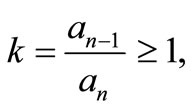 in Theorem 1.1 we obtain the following result which is a generalization of Corollary 2 ([7]).
in Theorem 1.1 we obtain the following result which is a generalization of Corollary 2 ([7]).
COROLLARY 1. Let
 be a polynomials of degree n. If for some positive real number
be a polynomials of degree n. If for some positive real number
 (7)
(7)
then all zeros of P(z) lie in

REMARK 1. Theorem 1.1 is applicable to situations when Enestrom-Kakeya Theorem gives no information. To see this consider the polynomial.

with  is a positive real number. Here EnestromKakeya Theorem is not applicable to P(z) where as Theorem 1.1 is applicable with
is a positive real number. Here EnestromKakeya Theorem is not applicable to P(z) where as Theorem 1.1 is applicable with 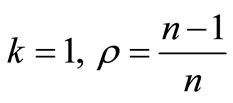 and according to our result, all the zeros of P(z) lie in the disk.
and according to our result, all the zeros of P(z) lie in the disk.
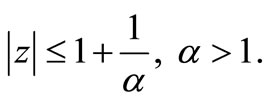
which is considerably better than the bound obtained by a classical result of Caushy ([4]) which states that all the zeros of P(z) lie in

where
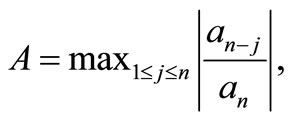
Next, we present the following generalization of corollary 1 which includes Theorem 4 of [6] as a special case and considerably improves the bound obtained by Dewan and Bidkham ([8], Theorem1) for t = 0 and  .
.
THEOREM 1.2. Let
 be a polynomial of degree n. If for some positive number
be a polynomial of degree n. If for some positive number  and for some non-negative integer
and for some non-negative integer 
 (8)
(8)
then all the zeros of P(z) lie in
 (9)
(9)
Applying Theorem 1.2 to P(tz), we get the following result:
COROLLARY 2. Let
 be a polynomial of degree n. If for some positive numbers t and
be a polynomial of degree n. If for some positive numbers t and  with
with ,
,

where  is a non negative integer then all the zeros of P(z), lie in
is a non negative integer then all the zeros of P(z), lie in

If we assume a0 > 0, in Theorem 1.2, we obtain.
COROLLARY 3. Let
 be a polynomial of degree n. If for some positive numbers
be a polynomial of degree n. If for some positive numbers and for same non-negative integer
and for same non-negative integer 


then all the zeros of P(z) lie in,
 (10)
(10)
Finally we present all following generalization of Theorem B due to Joyal, Labelle and Rahman which includes Theorem A as a special case.
THEOREM 1.3. Let
 be a polynomial of degree n, It for some positive number
be a polynomial of degree n, It for some positive number  and for some non-negative integer
and for some non-negative integer 

then all the zeros of P(z) lie in
 (11)
(11)
REMARK 2. For , Theorem 1.3 reduces to Theorem B.
, Theorem 1.3 reduces to Theorem B.
3. Proofs of the Theorems
PROOF OF THEOREM 1.1. Consider

then for  we have
we have
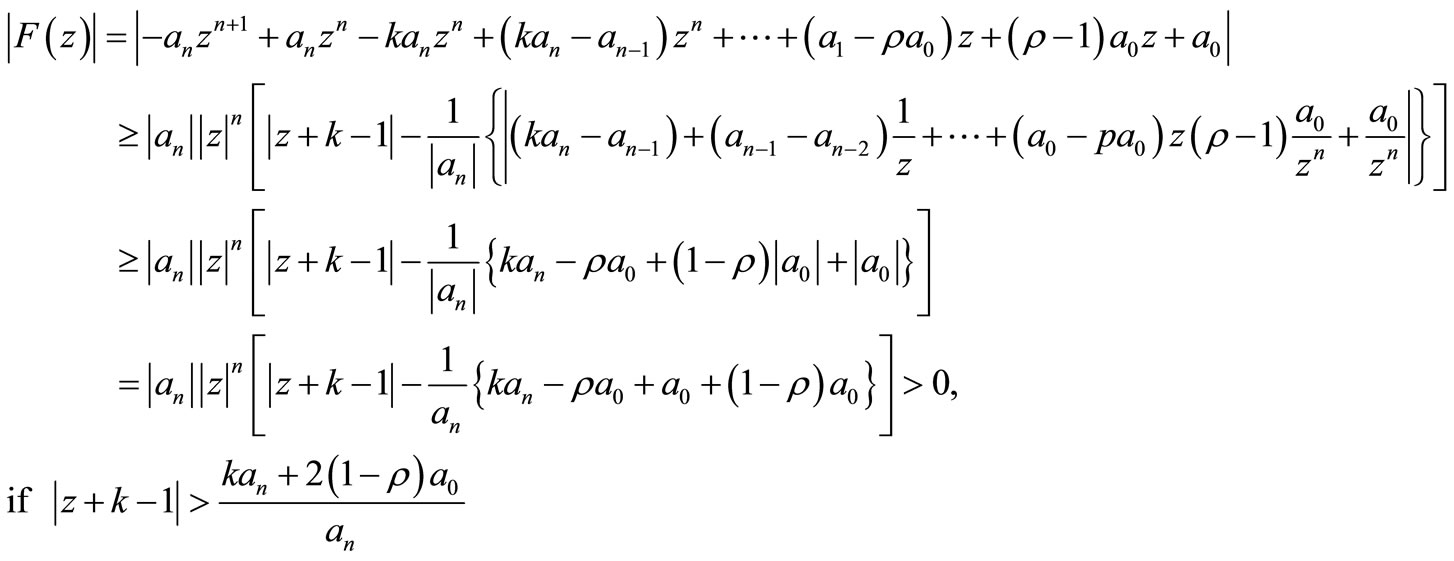
this shows that if  then
then , if
, if

therefore all the zeros of F(z), whose modulus is greater than 1 lie in the closed disk

But those zeros of F(z) whose modules is less than or equal to 1 already satisfy the Inequality (6).
Since all the zeros of P(z) are also the zeros of F(z). therefore it follows that all the zeros of P(z) lie in the circle defined by (6). Which completes the proof of Theorem 1.1.
PROOF OF THEOREM 1.2. Consider

therefore, for  and
and ,we have
,we have
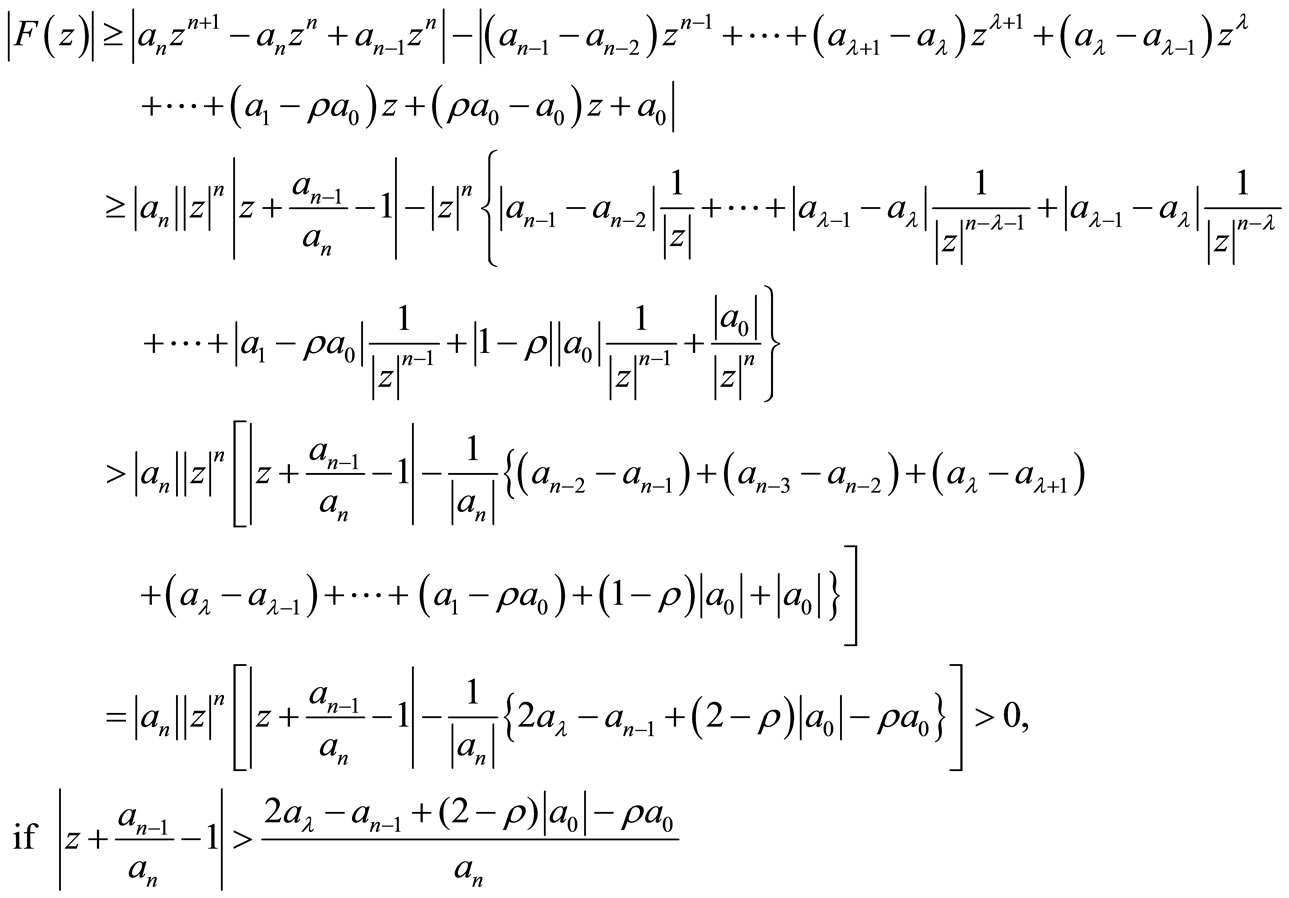
Therefore all the zeros of F(z) whose modulus is greater than 1 lie in the circle.

But those zeros of F(z) whose modulus is less than or equal to 1 already satisfy the Inequality (9).
Since all the zeros of P(z) are also the zeros of F(z), therefore it follows that all the zeros of P(z) lie in the circle defined by (9). This completes the proof of Theorem 1.2.
PROOF OF THEOREM 1.3. Consider

therefore, for  we have
we have

Proceeding similarly as in the proof of Theorem 1.2, we have

therefore all the zeros of F(z) whose modules is greater than 1 lie in the circle

But those zeros of F(z) whose modulus is  already satisfy the (11). Since all the zeros of P(z) are also the zero of F(z), therefore it follows that all the zeros of P(z) lie in circle defined by (11) and hence Theorem 1.3 is proved completed.
already satisfy the (11). Since all the zeros of P(z) are also the zero of F(z), therefore it follows that all the zeros of P(z) lie in circle defined by (11) and hence Theorem 1.3 is proved completed.
4. Acknowledgements
The authors are grateful to the refree for useful suggestions.
REFERENCES
- P. V. Krishnalah, “On Kakeya Theorem,” Journal of London Mathematical Society, Vol. 20, No. 3, 1955, pp. 314- 319. doi:10.1112/jlms/s1-30.3.314
- A. Aziz and Q. G. Mohammad, “On the zeros of a certain class of polynomials and related analytic functions,” Journal of Mathematical Analysis and Applications, Vol. 75, No. 2, 1980, pp. 495-502. doi:10.1016/0022-247X(80)90097-9
- N. K. Govil and Q. I. Rahman, “On the Enestrom-Kakeya Theorem II,” Tohoku Mathematical Journal, Vol. 20, No. 2, 1968, pp. 126-136. doi:10.2748/tmj/1178243172
- M. Marden, “Geometry of Polynomials,” 2nd Edition, Vol. 3, American Mathematical Society, Providence, 1966.
- G. V. Milovanovic, D. S. Mitrovic and Th. M. Rassias, “Topics in Polynomials, Extremal Problems Inequalities, Zeros,” World Scientific, Singapore, 1994.
- A. Joyal, G. Labelle and Q. I. Rahman, “On the location of zeros of polynomial,” Canadian Mathematical Bulletin, Vol. 10, 1967, pp. 53-63. doi:10.4153/CMB-1967-006-3
- A. Aziz and B. A. Zargar, “Some Extensions of Enestrom Kakeya Theorem,” Glasnick Matematicki, Vol. 31, 1996, pp. 239-244.
- K. K. Dewan and M. Bidkham, “On the Enestrom Kakeya Theorem,” Journal of Mathematical Analysis and Applications, Vol. 180, No. 1, 1993, pp. 29-36. doi:10.1006/jmaa.1993.1379

